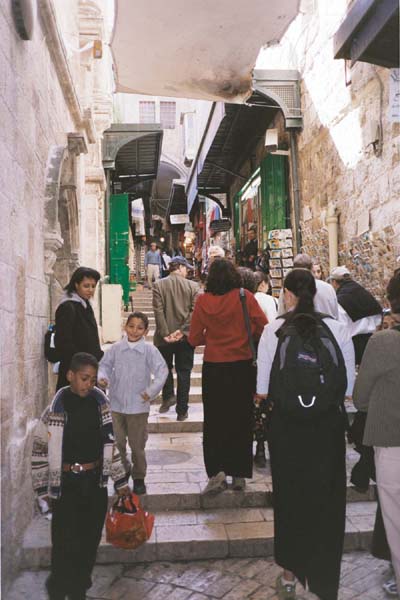|
A
Volatile Land, Yet and International Attraction
|
|
by
Hay-Mie Cho
|
Bombs exploding on the streets and the eruptive gunfire leaving dozens dead have dominated headlines worldwide for half a year, as the Palestinians and Israelis continue their struggle to settle their differences. Among the many victims of the conflict has been the tourism industry. Cities such as Jerusalem, Bethlehem and Nazareth have seen such steep declines in tourism that hotels have closed and thousands are out of work. Tourism officials say that the number of visitors is down 75 percent from last year. But despite the dangers and the downturn, one group of tourists continues to come to Israel and the Palestinian territories: the religious pilgrims, the true believers who continue to flock to this region.
For example,
in January, four months after the hostilities erupted, Jessica Dacey
ventured from her native Bath, England to the Shrine of the Bab, which
is "the most special place in the world" for followers of the Baha'i
faith. Having studied the independent, monotheistic religion in her
youth, Dacey said she decided to become a member and devote six months
of her life to the shrine because "a belief in the future of humanity"
and helping others in the community are central themes. In spite of
the violence, she said she needed to be surrounded by the beauty that
defines the shrine on Mount Carmel in Haifa. There, she is serving as
a press officer for its Office of Public Information and assisting with
the opening of its new gardens in May.
As Dacey, 30, stood overlooking the surrounding gardens of red, yellow, orange, and purple flowers flourishing on fresh green grass, she said, "It's a place to meditate. Its beauty is to uplift your soul.
"You could feel the history around you," Dacey, a freelance journalist, added, "because you become close to people who have given up their lives for something."
Though she has
been at the shrine for only two months, she said she already feels "a
close connection" to her colleagues.
 |
The shrine, an imposing white palace topped with a copper-like dome sitting atop a lush green hill, and its gardens symbolize peace, sacrifice, and devotion for Marcia Lample, a tour guide, as well.
Lample, 45, came to the shrine seven years ago from Florida when her husband took a position in local economic and social development in Haifa."I never thought it would be an option as a place where we could live," she said.
Should her husband accept another job elsewhere, the whole family plans to join him, but Lample acknowledged that the experience at the shrine has been invaluable for her three children.
"They'll meet people from places they've never visited before," she said. "They'll learn a sense of oneness, worldliness. "The U.S. seems so isolationist," she added. "We don't focus so much outside the U.S. because we have so many things."
Another location where pilgrims continue to come despite the violence is the Yardenit Baptismal site sitting peacefully by the Jordan River and offering visitors the opportunity to be baptized. Some prefer to stand by the brick walls overlooking the river and bear witness to the ritual, while others decide to immerse themselves completely in the frigid water. Those who choose to do so include both persons already baptized and those who are not. They may undergo the experience in one of two ways. They may rent a white gown and towel for $6 and along with a minister wade waist-deep wearing the robe and a bathing suit underneath into the river, where the minister submerges them fully into the water. Others may choose instead to stand fully clothed with or without shoes at the side of the river, and the minister will simply scoop a handful of water from the river and sprinkle it onto one's head. Those who opt to submerge themselves completely into the water inevitably emerge shivering as the robe clings to their bodies, but they hold the experience so dear.
"First, it feels cold," Adam Hamilton, the senior pastor of the United Methodist Church of the Resurrection in Leawood, Kansas, said.
"After that, it's actually a blessing to see our folks embrace Christ."
Leading a tour group of members from the church for 10 days, he waded into the river to baptize and renew both members and strangers, reminding them that baptism meant their commitment to a covenant with God.
Larry Van Sickle, a member of the church who hails from Overland Park, Kansas had been baptized before, but when the group visited the site he decided he wanted a renewal of the experience. Dutifully donning the white robe, he ventured into the calm river with Hamilton.
"Full immersion is giving up your self, being born again when you come up again because of the Jordan River that's where John Baptist baptized Jesus," Van Sickle, 56, said.
"Other than being cold, it's a display that I want to follow Christ."
Of his church traveling to the Holy Land, Hamilton, 36, said, "This is real, this is not make believe when they come to the Holy Land. My hope was that when they go home, they would never read the Bible the same way again."
"It's really a pilgrimage," Hamilton said.